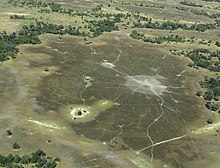Beaten path


Trample path or path is a name for a narrow footpath without many branches. The word “trampling path” is formed from “trample” (reinforcement of stepping) and “path” (footpath). Footpaths are created by people or animals frequently walking the same stretches of road in impassable areas and are the most original type of path. A path is sometimes difficult to make out in the terrain and can usually only be walked one after the other.
Footpaths represent a route optimization and thus follow a need . A large number of people or animals are usually involved in the formation of a beaten path. Well-trodden paths are a shortcut, a more comfortable way or the only passable way around obstacles. In designed environments such as urban green spaces, they are typically undesirable, but they are created nonetheless, even without the consent of or against the intentions of the owners.
Idioms
Idioms about the path suggest that it is often arduous to walk ( treading narrow paths , i.e. exploring unsafe terrain, or walking the path of virtue , i.e. walking through life without error or sin). Taking a crooked path is like considering wrong ways of doing things. On the other hand, those who go on the well- trodden path do not risk any innovations and are largely pragmatic . In the increase, intellectual trails stand for particularly stubborn, unimaginative, well-worn thinking.
Regularities
Since the first investigations into pedestrian traffic in the 1960s, it has been clear that the apparently “chaotic” movement of pedestrians is subject to certain regularities. This is especially true for pedestrians who have a specific destination. To get there, pedestrians usually choose the shortest route. The reluctance of pedestrians to take detours is extremely high, even if the direct route is slow. If the existing paths are unfavorable, so that larger detours would have to be accepted, unplanned path systems , the beaten paths , arise on the direct route . These have some characteristic properties:
- Crossing of three paths: the beaten paths nestle against each other, i. H. they do not run straight at the junctions or branches, but rather curvy.
- Intersection of four paths: If two paths intersect, keep their (straight line) course.
- More heavily frequented trails are wider than less frequented ones.
- If a beaten path becomes impassable (due to a barrier or the like), a new one is formed parallel to it.
Landscape architecture
Trample paths can be used consciously as a design tool, among other things to create efficient routing. An example was created on the University of Oregon (Eugene) campus , where in the late 1960s students were fighting for participation in the reorganization of the university. The university management engaged the Viennese architect Christopher Alexander . According to his plan, the area between the university buildings was leveled and sown with lawn. The trails that emerged after months were transformed into paved paths ("Desire Lines").
In terms of route optimization, trails often represent a better solution than the one planned by the architects. In some cases, landscape architects included already existing beaten tracks in their planning. Plans are also known in which target-oriented paths (e.g. between residential houses in a settlement ) were completely dispensed with and the emergence of trails was waited for. Fixed paths were later set up on the routes of these trails. In this way, an “automatic” route optimization was achieved and the creation of additional trails that would have damaged the vegetation and the appearance of the facility was avoided.
See also
Web links
- Go your own way outside . Magazine of the Süddeutsche Zeitung . Issue 32/2010. Interview with Dirk Helbing on the emergence of beaten tracks ( long version from August 14, 2010 ( memento from November 22, 2010 in the Internet Archive )).
Individual evidence
- ↑ a b c d Dirk Helbing: Verkehrsdynamik . Springer, 1997, ISBN 3-540-61927-5 , pp. 5 f .
- ↑ Eda Schaur: Unplanned Settlements . Krämer, Stuttgart 1992, ISBN 3-7828-2039-8 .
- ↑ Sascha Lobo : The man-machine: The swarm is only interested in the result. Spiegel Online , April 2, 2013, accessed November 18, 2013 .
- ^ Greg Bryant: The Oregon Experiment after Twenty Years . In: Rain 14,1 (Winter / Spring 1991) ( Memento from May 28, 2007 in the Internet Archive ).
- ↑ Christopher Alexander: The Oregon experiment. Oxford University Press, New York 1975 (= Center for Environmental Structure series 3), ISBN 978-0-19-501824-0 .
